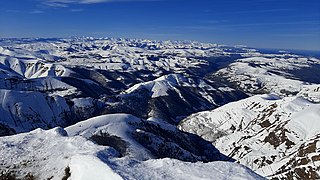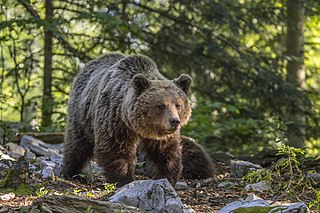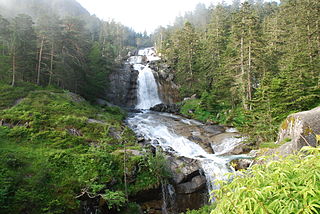
The brown bear is a large bear species found across Eurasia and North America. It is one of the largest living terrestrial members of the order Carnivora, rivaled in size only by its closest relative, the polar bear, which is much less variable in size and slightly bigger on average. The brown bear's range includes parts of Russia, Central Asia, the Himalayas, China, Canada, the United States, Hokkaido, Scandinavia, Finland, the Balkans, the Picos de Europa and the Carpathian region, Iran, Anatolia, and the Caucasus. The brown bear is recognized as a national and state animal in several European countries. In North America, the populations of brown bears are called grizzly bears, while the subspecies that inhabits the Kodiak Islands of Alaska is known as the Kodiak bear.

The Picos de Europa are a mountain range extending for about 20 km (12 mi), forming part of the Cantabrian Mountains in northern Spain. The range is situated in the Autonomous Communities of Asturias, Cantabria and Castile and León. The highest peak is Torre de Cerredo, at an elevation of 2650 m (8,690 ft).

The Cantabrian Mountains or Cantabrian Range are one of the main systems of mountain ranges in Spain. They stretch for over 300 km (180 miles) across northern Spain, from the western limit of the Pyrenees to the Galician Massif in Galicia, along the coast of the Cantabrian Sea. Their easternmost end meets the Sistema Ibérico.

The Eurasian brown bear is one of the most common subspecies of the brown bear, and is found in much of Eurasia. It is also called the European brown bear, common brown bear, common bear, and colloquially by many other names. The genetic diversity of present-day brown bears has been extensively studied over the years and appears to be geographically structured into five main clades based upon analysis of the mtDNA.

The Gobi bear, known in Mongolian as the Mazaalai (Мазаалай), is a subspecies of the brown bear that is found in the Gobi Desert of Mongolia. It is listed as critically endangered by the Mongolian Redbook of Endangered Species and by IUCN standards. Currently, there are only 31 bears left in the Mongolian Gobi Desert, which results are based on the long-term genetic monitoring and the population is relatively stable, however, the sex ratio is highly skewed towards to males. Gobi bears are separated by enough distance from other brown bear populations to achieve reproductive isolation. In 1959, hunting of the animal was prohibited in order to preserve the dying subspecies.

The Marsican brown bear, also known as the Apennine brown bear, and orso bruno marsicano in Italian, is a critically endangered population of the Eurasian brown bear, with a range restricted to the Parco Nazionale d'Abruzzo, Lazio e Molise, and the surrounding region in Italy. The Marsican brown bear differs slightly from other brown bears in its appearance and hibernation techniques. The bear's popular name is derived from Marsica, a historic area of the modern-day region of Abruzzo where the bear has long had a significant presence.

San Glorio is a mountain pass in the Cantabrian Mountains of Northern Spain. The pass reaches an elevation of 1610 meters along the national highway N621 which connects the city of León with Cantabria and which passes through Asturias. The pass is situated some 800m from the southern border of the Picos de Europa National Park, a park included in UNESCO's World Network of Biosphere Reserves and shared by the provinces of León, Asturias and Cantabria. The valleys of this part of the Cantabrian Mountains include sites in the European Union's Natura 2000 network and Special Protection Areas for the conservation of wild birds. San Glorio is used as a corridor by the Cantabrian brown bear Ursus arctos, catalogued in Spain as being in danger of extinction. Moreover, the slopes of the glacial valleys making up the surrounding region are home to an important variety of plant life.

Bear conservation refers to the management of bears and their habitat with a view to preventing their extinction.

Bear hunting is the act of hunting bears. Bear have been hunted since prehistoric times for their meat and fur. In addition to being a source of food, in modern times they have been favored by big game hunters due to their size and ferocity. Bear hunting has a vast history throughout Europe and North America, and hunting practices have varied based on location and type of bear.

The Redes Natural Park is located in the Principality of Asturias in northern Spain. Its total area is 377.36 km2 (145.70 sq mi), split between two municipalities: Caso and Sobrescobio. It was declared a natural park in 1996.

Somiedo Natural Park is a protected area located in the central area of the Cantabrian Mountains in the Principality of Asturias in northern Spain. As well as being designated a natural park, it is protected as a Special Area of Conservation, and as one of a number of Biosphere Reserves in the Cantabrian mountains.(see note)

Montaña Palentina is a natural park in the north of the province of Palencia in Castile and León, Spain.
The Cantabrian capercaillie is a subspecies of the western capercaillie in the grouse family Tetraonidae. It is one of two subspecies found in Spain.

The Cantabrian Water Dog is a landrace breed of dog developed in the coast of Cantabria, northern Spain, as an assistant to fishermen. The breed was classified and recognized by the Breeds Committee of the Spanish Ministry of Environment on 22 March 2011. It is recognised by the Royal Canine Society of Spain as a variety of the Spanish water dog.
The Muniellos Nature Reserve is a protected area of woodland in Asturias, Spain. The area of the nature reserve is 5,488 ha. The main species of tree is oak: it has been described as probably the best preserved Quercus robur forest in Spain.

The Cantabrian chamois is a slim mountain goat-antelope, and is one of the 10 subspecies of the genus Rupicapra. It ranges the Cantabrian Mountains in northern Spain, with a population of 17,000 animals in 2007-2008.
Formerly or currently considered subspecies or populations of brown bears have been listed as follows:

The Cantabrian mixed forests is a temperate broadleaf and mixed forests ecoregion in southwestern Europe. It extends along the coastal Cantabrian Mountains and Galician Massif of Northern Spain, extending south into northern Portugal, and northwards through the westernmost Pyrenees to southwestern France. The ecoregion extends from the seacoast to the highest peaks of the Cantabrian Mountains. The highest peak is Torre Cerredo at 2,648 meters elevation.

The Pyrenees conifer and mixed forests is a temperate broadleaf and mixed forests ecoregion in southwestern Europe. It extends along the Pyrenees mountains which run east and west along the border between France and Spain, and includes all Andorra. The ecoregion extends from the lower slopes of the Pyrenees to its highest peaks, which include Aneto, Posets, and Vignemale.

Brown bears were once native to Europe, much of Asia, the Atlas Mountains of Africa, and North America, but are now extirpated in some areas, and their populations have greatly decreased in other areas. There are approximately 200,000 brown bears left in the world. The largest population is in Russia, with 120,000 individuals. The brown bear occupies the largest range of habitats of any Ursus species with recorded observations in every temperate northern forest and at elevations as high as 5,000 m.























